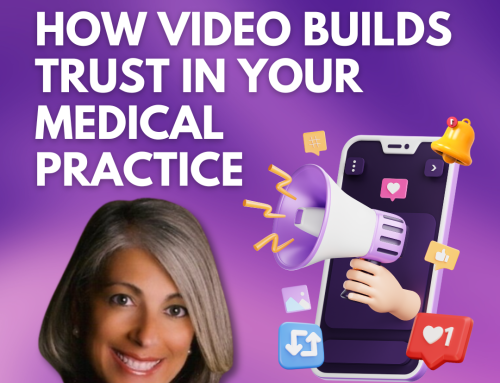Podcast: Play in new window | Download
Subscribe: RSS
In this episode, Barbara discusses:
- Why do doctors need to blog
- How can blogging establish professional authority and attract patients
- Who can help with creating effective blog content and titles
Key Takeaways:
“Respect your readers’ time by writing headlines that promise content you can substantiate.” – Dr. Barbara Hales.
Connect with Barbara Hales:
Twitter: @DrBarbaraHales
Facebook: facebook.com/theMedicalStrategist
Business Website: www.TheMedicalStrategist.com
Email: halesgangb@aol.com
YouTube: https://www.youtube.com/TheMedicalStrategist
LinkedIn: www.linkedin.com/in/barbarahales
Books:
Content Copy Made Easy
14 Tactics to Triple Sales
Power to the Patient: The Medical Strategist
TRANSCRIPTION (143)
Blogging for Doctors
Dr. Barbara Hales: Welcome to another episode of Marketing Tips for Doctors. I’m your host, Dr. Barbara House. Today, we are going to talk about why doctors need to blog.
Dr. Barbara Hales: You’ve designed and equipped your medical office, taking location into consideration check. You’ve trained your staff to be friendly, helpful and efficient. And you have established routines for insurance and local business referrals. Check. You’re confident that this medical practice is just what your patients would want and need. Then you’ve opened your office to crickets. No one is walking through the door. The problem is that you may be invisible.
Dr. Barbara Hales: So how does your medical practice get seen? How do prospective patients find out about blogging? That’s the answer. Not only does blogging add fresh content to your website, but it also directs search engine traffic to you, promotes your services, and helps you build trust with patients.
Dr. Barbara Hales: Blogging attracts prospective patients and enables them to engage with you. Search engines want new and fresh content on your website regularly. So do your patients. If they see a site with no fresh material, it’s reasonable to think that the doctor retired, moved, or died. Certainly, the doctor wouldn’t be up to date.
Dr. Barbara Hales: I heard and then corroborated this in my reading that attaching a blog to your site and posting on it consistently was viewed as fresh content. So soon after launching my website, I launched my blog as well. This rewarded me with engaging viewers by asking questions, commenting, and giving likes and effort rewarded.
Dr. Barbara Hales: Many doctors ask after starting a practice whether blogging is still effective or is it too old school. The answer is a resounding yes, and here are the reasons why.
Dr. Barbara Hales: Firstly, it establishes professional authority. People are searching online all the time to get information about their health. Why shouldn’t it be from you? When you consistently post content viewed as valuable for your audience, the greater you will be viewed as an authority to them. The more articles you publish about medical issues that are in sync with your practice, the more you will be seen as an authority in your field. Secondly, blogs enable you to share breaking medical news or all this news like new equipment, new services, or stories. The articles highlight what you are up to, whether it is a charity event, community health fair, or interviews you’ve given online and in the media. Posts can discuss medical conditions and treatment options, surgeries, and medications informing readers who would be good candidates for pre- and post-care instructions. The list is endless. Your blogs offer an opportunity to add comments and respond to you or ask questions. Encourage readers to leave comments and invite conversations and reactions to your post. An engaged viewer is an interested viewer who becomes an active patient.
Why Your Medical Practice Needs a Blog
Dr. Barbara Hales: Blogs can be posted on social media, increasing visibility and driving people to your website. Provide solutions to questions that you see in various forums and chat rooms. Encourage conversation so that viewers want to refer to your website for more information.
Dr. Barbara Hales: Once you have amassed a collection of your blog posts, you can then use them for books both digital and hardcopy, manuals, videos, and podcasts like you’re listening to right now. With each blog post, one more index page is created which means another chance for you to show up on the search engine’s result page, sending more traffic to your website.
Dr. Barbara Hales: Search engines drive traffic blogs and help search engines know what you’re all about through backlinks or inbound links establishing domain authority. When viewers respond to your articles, especially influencers or industry leaders, you get relevant links, which serve as a recommendation from other websites. This activates search engine algorithms to recognize you as an expert in your field.
Save Time and Money
Dr. Barbara Hales: Blogs save money. Advertising, your medical practice can be pretty pricing. However, once your website and the blog platform are set up, the cost to blog is minimal. It enables you to share each post on social media platforms like Facebook, LinkedIn, Twitter, and Instagram, further driving traffic back to your website.
Dr. Barbara Hales: Lastly, blogs save time. Are you really saving time by creating posts and publishing them? The answer is a resounding yes. There are certain questions and topics that your medical practice gets regularly. Both you and your staff have to answer them by phone or take up valuable examination appointments by going over replies over and over throughout the day. Instead, by having topics in general questions answered by blog posts, you’ll have the opportunity to educate your patients on them. Provide solutions and address concerns, thereby saving time from repetitive questions.
Dr. Barbara Hales: Yes, having a blog is a time commitment. Ask yourself if you have time to manage a blog yourself. A great relief is to get the benefits of blogging without sacrificing time to spend on your business or with family and friends outsourcing it.
Engage Your Patients and Attract Prospective Ones
Dr. Barbara Hales: Mind that is not just a question of putting out a blog post or a podcast. It is one that your target market or patients’ prospective or current would be interested in. You have to take your blog post and title from being ho-hum to a must-read. The goal and publishing blog posts as a health professional is to engage your patients and attract prospective ones. But you need more than just putting out content. You may be doomed if your headline is boring, doesn’t speak to your audience, or is simply old hat.
Dr. Barbara Hales: Your titles are the most important aspects of your blog posts. 85% of viewers will decide whether to delete or read your message based on the title and headlines alone. Creating a well-researched article is more frustrating than creating a well-researched article only to find it goes unshared or deleted. A lot of people are well-versed in quickly hitting that delete button. When I first started reading blog posts, I became a master of the delete button. Time is precious, so I wanted to use it wisely by reading uninteresting information that did not pertain to or appeal to me.
Dr. Barbara Hales: As time went on, it was easy to recognize who put up posts that I found funny, interesting, or valuable in terms of actions that I could implement. Now, there are more than 600 million blogs. Reading through the noise makes it harder to find posts worth reading. I determine which ones are for me by the subject line as the title attracts me like a moth to a flame.
Dr. Barbara Hales: Isn’t that how you quickly decide to read or delete? I have a blog that was started more than 10 years ago. By the open and bounce rates, I can see what attracts people, engages them, and turns them off. The one thing that makes blogs attractive to others is the ability to address pain points and elicit emotions, but there are steps to implement to make your post irresistible. Here are five keys to making your blog post title go from O to irresistible:
Dr. Barbara Hales: First, keep it short and simple. Try to limit your blog post titles to five to eight words. Another way of writing a headline is to ask: “How will I explain this blog post to a friend?” Secondly, focus on only one central idea; don’t muddle your post with several messages. The headline should answer the five W’s and H – what, where, when, why, who, and how – most journalists know this already. Thirdly, be unique and share your flair. If your viewers have read the information before, it’s unlikely to get read again. Be different, or have a new, unique slant, and let your personality shine through. Add some color and elicit emotions or curiosity. The most important aspect of the headline is that it answers the question: “What’s in it for me?” Provide solutions to the problems your readers are struggling with. Google has allowed us the venue to find fast answers to urgent questions. You just interact with search engines like Google, a user experience a need for a solution, answer, or piece of information. With these things in mind, you can craft your headline as straightforwardly as possible. If your blog post talks about a solution to a problem, if a headline is informative, relevant, and engaging, it will likely get clicked. However, The thing to remember is to make sure that the article and headline are in sync with the services you provide. Lastly, pique curiosity without adding drama.
Dr. Barbara Hales: Nobody likes a drama queen. Keep the sensationalism out of your headline unless you’re writing for a tabloid. However, you can be contrarian to get attention. The thing is, tabloid headlines often tend to over-promise with no support for the content provided. Readers will feel like they’ve been tricked into reading the whole article. This is something you want to avoid doing to your readers. Respect your reader’s time by writing headlines that promise content you can substantiate.
Dr. Barbara Hales: These are just five ways you can craft an irresistibly appealing blog post title to give your content the time and attention it deserves. Need help thinking of the headline you need to run by me with a free consultation schedule at the Medical Strategist dot A s dot M A and click discovery call. Let’s get you started on attracting new patients and retaining current ones. I’ll speak to you then.
Dr. Barbara Hales: This has been another episode of Marketing Tips for Doctors. Speak to you soon.



